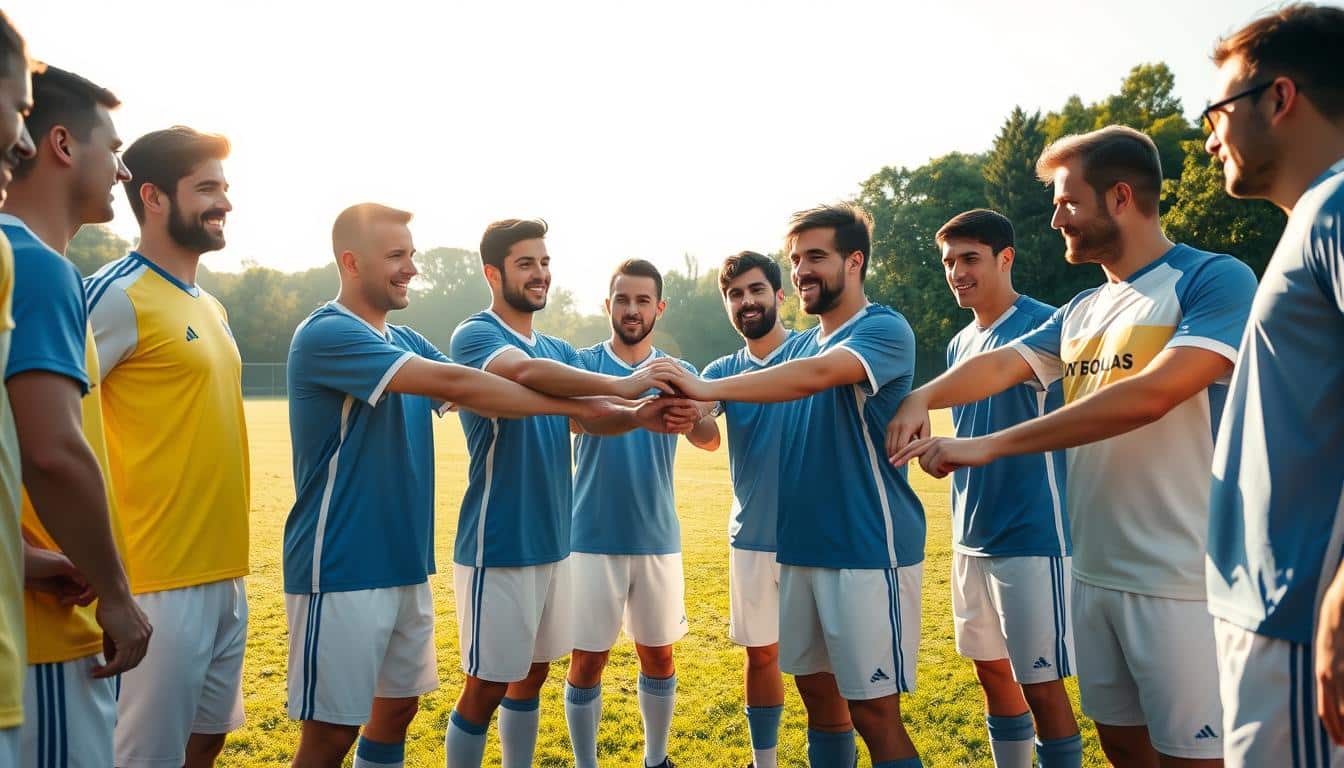Trust Exercises for Soccer Teams

What separates good squads from championship-winning groups? The answer isn’t just talent or tactics—it’s trust. When players rely on one another, they move like a single unit, anticipate challenges, and thrive under pressure. This connection doesn’t happen by accident. It’s built through intentional activities designed to strengthen bonds and communication.
Whether you’re coaching a youth league or leading a pro roster, fostering mutual respect is non-negotiable. Teams that prioritize cohesion see fewer misunderstandings during games and recover faster from setbacks. The best part? These strategies work for all skill levels and age groups.
Key Takeaways
- Trust transforms individual players into a unified, resilient group.
- Strong bonds lead to faster decision-making during high-pressure moments.
- Consistent practice builds lasting communication habits.
- Chemistry off the field directly impacts performance during matches.
- Simple activities can bridge gaps between teammates of all experience levels.
Understanding the Role of Trust in Team Performance
Championship-level success hinges on more than skill—it’s rooted in how well athletes connect. When groups prioritize open dialogue and mutual respect, they create a foundation where strategies thrive. Clear communication acts like glue, ensuring everyone moves toward the same goal without hesitation.
Building Communication on the Field
Strong squads use simple codes and signals to share critical updates mid-game. For example, a hand gesture or short call can signal a shift in formation. This reduces confusion and keeps plays flowing smoothly.
Active listening matters just as much as speaking up. When players tune into each other’s cues, they adapt faster to challenges. Mistakes become learning moments instead of blame games, thanks to supportive feedback.
Benefits of Strong Team Bonds
Groups with tight chemistry recover quicker from setbacks. They know their peers have their back, which boosts confidence during high-pressure moments. Off-field bonding also translates to sharper instincts during matches.
Trust lets athletes focus on their roles without second-guessing others. Defenders coordinate seamlessly with midfielders, while forwards anticipate passes naturally. This harmony leads to fewer errors and more opportunities to dominate the game.
Practical Trust-Building Activities for Soccer Teams
Building a cohesive unit starts with intentional actions that blend learning with lighthearted moments. These activities break down barriers while sharpening communication skills needed on and off the field.
Ice Breakers and Name Games
Start with simple games like “Circle Introductions.” Players stand in a circle, sharing their name and a unique hobby. This sparks conversations and helps new members feel included quickly.
For younger squads, add a ball toss: Whoever catches it repeats a teammate’s fact before sharing their own. It’s fun and reinforces active listening.
Trust Falls and Blindfold Dribbling
Pair athletes for classic activities that build reliance. One partner falls backward while the other guides them safely. Rotate roles to emphasize mutual support.
Blindfolded dribbling adds a challenge: Players navigate cones using only verbal instructions from their guide. This sharpens clarity under pressure.
Group Challenges to Enhance Unity
The Human Knot is a crowd favorite. Groups interlock hands across a circle and untangle without breaking grips. It demands patience and creative problem-solving.
Adapt obstacle courses for different ages. Teens might race against the clock, while youth leagues focus on collaborative cheering. Both versions strengthen camaraderie through shared goals.
Soccer team trust exercises for On-Field Success
Turning practice into peak performance requires drills that mirror real-game intensity. These activities sharpen instincts while weaving teamwork into every movement. When athletes sync their actions, they create opportunities that leave opponents scrambling.
Drill-Based Activities to Boost Coordination
Relay races inject urgency into skill-building. Split your group into pairs or trios, challenging them to dribble through cones, pass accurately, and shoot on target. The twist? Each member must complete a segment before tagging the next. This builds rhythm under pressure.
For passing precision, try the 3-Second Rule. Players in different field positions must release the ball within three seconds of receiving it. Rotate roles to simulate live-game scenarios where quick decisions matter.
- Shooting Synergy: Design drills where two athletes must combine passes to unlock a scoring chance. For example, a give-and-go play leading to a shot.
- Defensive Communication: Goalkeepers call out positioning cues while defenders adjust based on verbal cues. Start with slow build-ups, then increase speed.
- Progressive Challenges: Begin with stationary passing sequences, then add movement and defensive pressure as confidence grows.
These methods transform isolated skills into collective strengths. When everyone knows their role—and trusts others to execute theirs—the goal becomes inevitable.
Tips and Tricks for Lasting Team Chemistry
Great squads aren’t built overnight—they’re crafted through daily habits that turn teammates into family. Focus on small, consistent actions to create a culture where everyone contributes and celebrates together.

Encouraging Open Communication
Start with quick daily check-ins. Ask each member to share one win and one challenge. This normalizes honesty and shows every player their voice matters.
| Method | Purpose | Time Needed |
|---|---|---|
| Feedback Circles | Strengthen communication without blame | 10 minutes |
| “Idea of the Day” | Collect creative ideas from all members | 5 minutes |
| Role Swap Discussions | Build empathy between positions | 15 minutes |
Simple Strategies for Daily Bonding
Try these low-effort team bonding boosters:
- Create a shared playlist where teammates add songs that pump them up
- Pair up members weekly for skill-sharing sessions
- End practices with a 2-minute fun game like trivia or quick charades
Remember: Building trust happens in stolen moments. A high-five after drills or checking in during tough days keeps connections strong over time.
Final Thoughts on Strengthening Your Team
Chemistry transforms good squads into unstoppable forces. Consistent activities that blend laughter with learning create bonds that survive tough matches and tight schedules. Focus on small daily habits—like celebrating wins or sharing ideas—to build a culture where everyone thrives.
Adapt drills to fit your group’s size and skill level. Short games during warm-ups or quick feedback circles keep energy high without eating into practice time. Watch for clearer communication during plays and smoother coordination under pressure—these signal your efforts are working.
Remember: Building trust isn’t a one-time task. Rotate partners often to strengthen connections across the entire roster. When challenges arise, lean on the camaraderie you’ve nurtured—it’ll help your athletes regroup faster and push harder.
Invest in these strategies, and you’ll see results where it matters most—on the field. Strong relationships fuel smarter decisions, quicker recoveries, and that championship mindset every coach dreams of.
